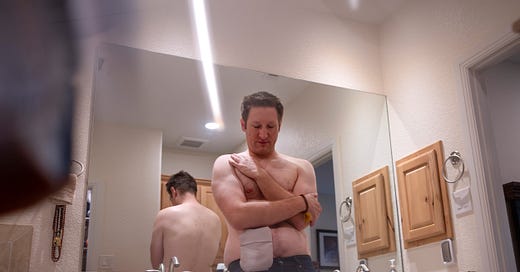Love After an Ostomy: How Surgery Affects Dating, Sex and Self-Perception
There are nearly one million people in the U.S. who live with an ostomy, and around 100,000 ostomy surgeries are performed each year.
Jake Golding found himself on Tinder messaging a match, excited at the thought of locking in a date.
But before he could ask the guy out, he needed to tell him something important. “I’m always thinking about when I’m going to bring it up,” Golding told Uncloseted Media. “What if it’s a dealbreaker?”
His fingers paused over the keyboard before typing: “I have an ostomy,” followed by a shaky thumb punch on the send icon.
A few minutes passed. Then a day. Eventually, he realized he had been ghosted.
Golding, 37, says that after he had his colon removed in 2022 because of severe ulcerative colitis, the physical and mental toll of having to wear an ostomy was “rough.”
“I'm single and having a hard time imagining any man finding my body attractive again with this large incision scar, bag and no large intestine,” says Golding, a former aromatherapist living in Austin, Texas.
There are three main types of ostomies—colostomy, ileostomy, and urostomy—each designed to reroute waste when elimination through the anus or urinary canal is not possible. After the surgery, going to the bathroom on a toilet is now a completely different process. By creating an opening—known as a stoma—in the abdomen wall, bowel movements are collected in an external pouch attached to the skin. There are nearly one million people in the U.S. who live with an ostomy, and around 100,000 ostomy surgeries are performed each year.
People receive ostomy surgery for a variety of health conditions, such as ulcerative colitis or rectal and colon cancer. While support groups do exist, there are still a lot of myths and stigmas surrounding ostomies, like smell and hygiene. Some people are choosing to die rather than undergo the surgery, partly due to their concerns about acceptance. For those who choose to go through with it, a new normal unfolds, and navigating body image, sex and dating are part of the process.
For Golding, adjusting to life with a stoma made everything more complicated. “The combination of bag and adhesives and all the technical stuff takes a while to figure out,” he says. “In the beginning, I didn't want to go out because I didn't know if I was going to have a leak. When you're always worried about whether you're going to have poop come out unexpectedly somewhere, it can make being out in public and socializing challenging.”
A 2019 study in the Journal of Nursing and Health Science found that three-quarters of stoma patients had poor body image and low self-esteem after the surgery. One of the most effective interventions for combating these feelings and maintaining well-being is self-acceptance, though that can be difficult as feelings of rejection, fear of being naked and embarrassment are common after surgery.
“I feel very, very self-conscious about it,” Graham Butler McIntosh, a 43-year-old from Glasgow, Scotland, told Uncloseted Media.
“I was in the best shape of my life before I got sick,” he says. “And now, I don't think my body looks nice at all. I'm the kind of person who bases a lot of my self-worth on my self-image, so loving myself now is hard.”
Butler McIntosh, who got an ileostomy two years ago after “the mother-of-all-flare-ups” of ulcerative colitis, says his ostomy bag runs through his mind any time he is in public. “I don’t like it being seen at all,” he says. “I remember once getting up and doing a karaoke performance and having a lot of fun. I sat down afterward and wondered if everybody could see [it]. What if it was hanging out?”
At the gym, Butler McIntosh hides his bag by wearing his towel higher than usual, double-checking that his T-shirt is tucked in tightly and leaving his shirt on in the locker room.
Like many gay men, Butler McIntosh places “so much stock” on his body being “nice to look at.” He says he is “never going to be happy with [his] body ever again.”
Golding also makes sure his bag is disguised at the gym. “Part of being masculine is being strong and independent, and my ostomy makes me feel vulnerable.”
“My friends and family have been reassuring, but that's not the same as having a boyfriend accepting you,” Golding says, adding that gay men tend to be “a lot more visually oriented.”
“I think that it takes a certain kind of person to look past my imperfections now, and I feel preoccupied on dates until I share with people [that I have an ostomy].”
While some dates have gone well, rejection is common and something that Butler McIntosh experienced the first time he met up with someone after the surgery.
Ahead of a “hook-up date,” Butler McIntosh—who is in an open marriage—told the guy that he had an ostomy. But when they met up and he took his shirt off, things got awkward. “He said my bag was scaring him … He turned around and wouldn't look at me, so I just put my clothes back on and left.”
“In so many ways, my confidence was just shattered.”
Since then, Butler McIntosh says that sometimes he won’t tell his sexual partners about his ostomy and just keep his shirt on. “It’s stressful. Sometimes, I have to try and spend a sexual encounter trying to hide it, getting their hands away from certain areas and not letting them do certain things. Or I lie down to hide it, which I shouldn't have to do.”
One reason that people choose to share about their ostomy is because the surgery can result in the anus hole being sewn shut, known as a Ken or Barbie Butt. And even if the anus is still intact, it can be dangerous to penetrate the rectum, making it difficult to receive anal penetration.
Butler McIntosh says it has changed the way he has sex with his husband of 15 years. “If he was the [top] and I was the [bottom], that's no longer physically possible. I cannot do that for him anymore. I miss it,” he says.
“That can be very devastating,” says Lorraine Grover, psychosexual nurse specialist. “If [receiving anal] is a big part of your life, it can change a lot of dynamics within the relationship.”
Grover says connecting to your body after ostomy surgery is essential. “Self-pleasure can be very helpful,” she says. “If we don’t know how our own body responds after surgery, it’s hard to include a partner in that. You have to know your own body first.”
She suggests experimenting with new toys, like an o-ring or a penis vacuum. These are especially useful if erectile dysfunction is an issue, which can be common after ostomy surgery due to nerve damage.
“Use the whole body and areas you haven’t tried before,” she says. “Kissing, touching, using the skin, which is a massive erogenous zone.” Some accessories can also be added to the stoma bag, like leather or lacey covers that resemble underwear.
“Intimacy is powerful, and you don’t have to give that up,” Grover says.
Gavin Skolnick, a 41-year-old chef living in the Bahamas, says that having partners who have been accepting and nonjudgmental of his ostomy has been a game changer regarding his body image.
“Gavin shared everything with me before we met so I wouldn’t be alarmed,” Tess Kvolek, Skolnick’s partner of six months, told Uncloseted Media. “I didn’t blink twice.”
“It’s not the most sexy thing,” she adds. “You go to the bathroom in a bag on your stomach. And on our first date, the bag fell off, and a small accident occurred on the floor. He was mortified. But I just brushed it off. Shit happens. We all have baggage—pun intended—some just looks a little different.”
Kvolek tells her boyfriend, "Wear that bag with pride. You survived cancer."
“I found with the right people, it was just easy. You don't have much control over it,” says Skolnick, who has had his bag for over 18 years after surviving colon rectal cancer when he was 22. He says his partner’s support and their communication has made everything feel “natural and comfortable.”
“Support is so important,” Linda Coulter, an ostomy nurse and a director at United Ostomy Associations of America, told Uncloseted Media. “Just asking, ‘What do you need from me?’ and demystifying the ostomy. Sometimes you can prepare, like going to the bathroom before [sex], not eating certain foods, and so on. Communication is really a huge part of it.”
“If you have a brain tumor or a heart condition, people immediately understand you're going through something big,” Coulter says. “When it happens to our intestines or waste management system, it's something we're taught from a very young age not to talk about. It’s behind a closed door. We need to normalize talking about that. Ostomies are lifesavers and people need to know that.”
For June Turner, a 29-year-old in Wichita, Kansas, that means sporting her ostomy with pride. “I don't want it to be some dirty little secret,” she says. Unlike many folks who hide their bag, Turner emphasizes it by wearing crop tops and even decking it out with different colored covers, including one that has “Hot Girl Shit” written overtop.
Back in Texas, Jake Golding is still adjusting to life with a stoma and continues to put himself out there. During one date last year, the conversation shifted to ostomies. This time, Golding’s date was the one who brought it up.
“By complete coincidence, he had survived colon cancer and also had an ostomy,” Golding says. “It was jarring at first, but then I felt very relieved that I was not the only person in the world suffering from this because it definitely feels like that sometimes. It was very comforting to know that someone else had been through something similar and survived.”
If objective, nonpartisan, rigorous, LGBTQ-focused journalism is important to you, please consider making a tax-deductible donation through our fiscal sponsor, Resource Impact, by clicking this button:













I have a family member who had a Urostomy. I was there when they got it and helped them with it, which taught me a lot.
It's not common and sounds scary to many. If you've never seen a stoma, it's a bit surprising at first.
Visibility is important to help increase people's knowledge and understanding. I commend the journalist and people interviewed for this article!
This is such powerful story telling. I am such a fan of these real vulnerable stories that help us call attention to the things we can do better in our communities. Thank you for sharing this with us all